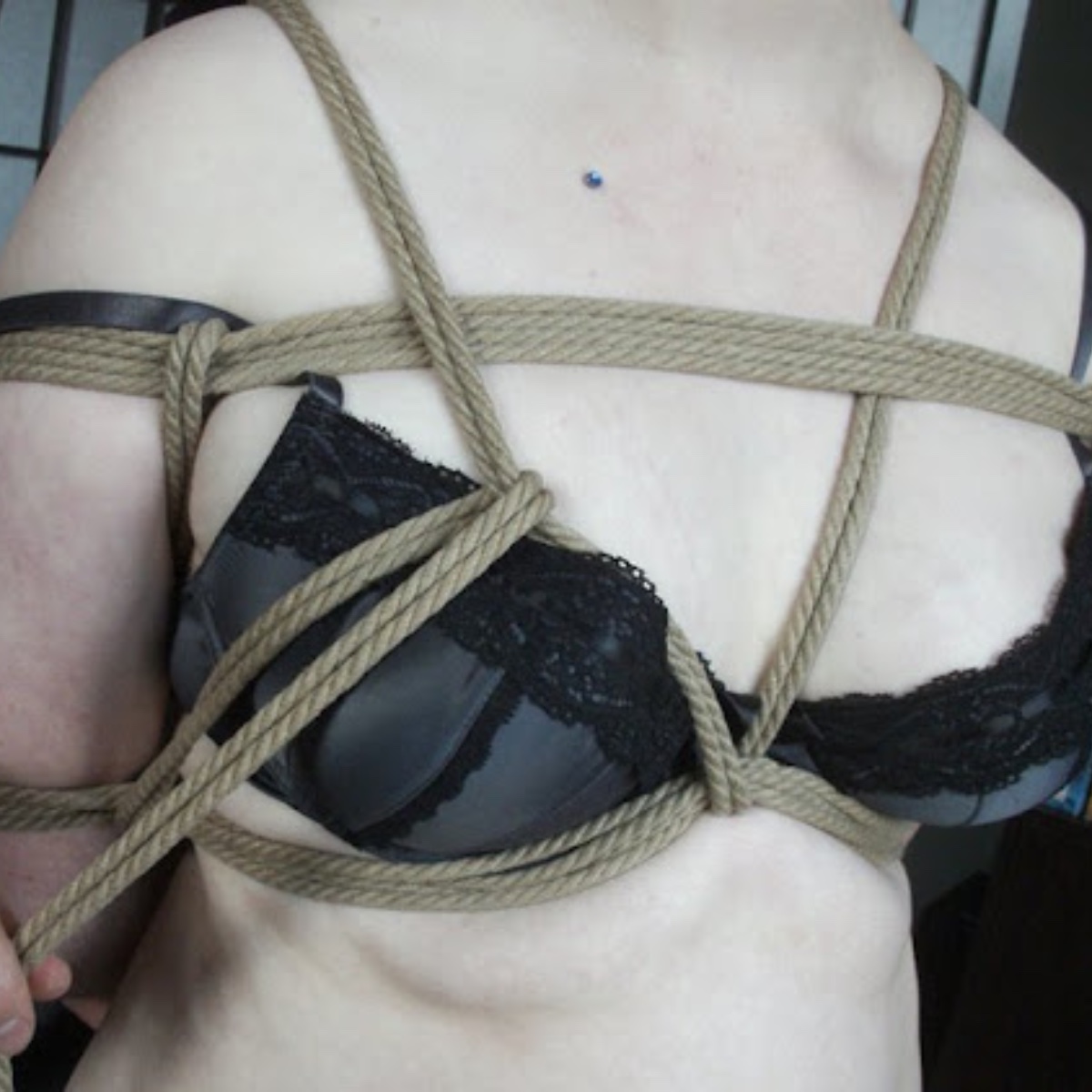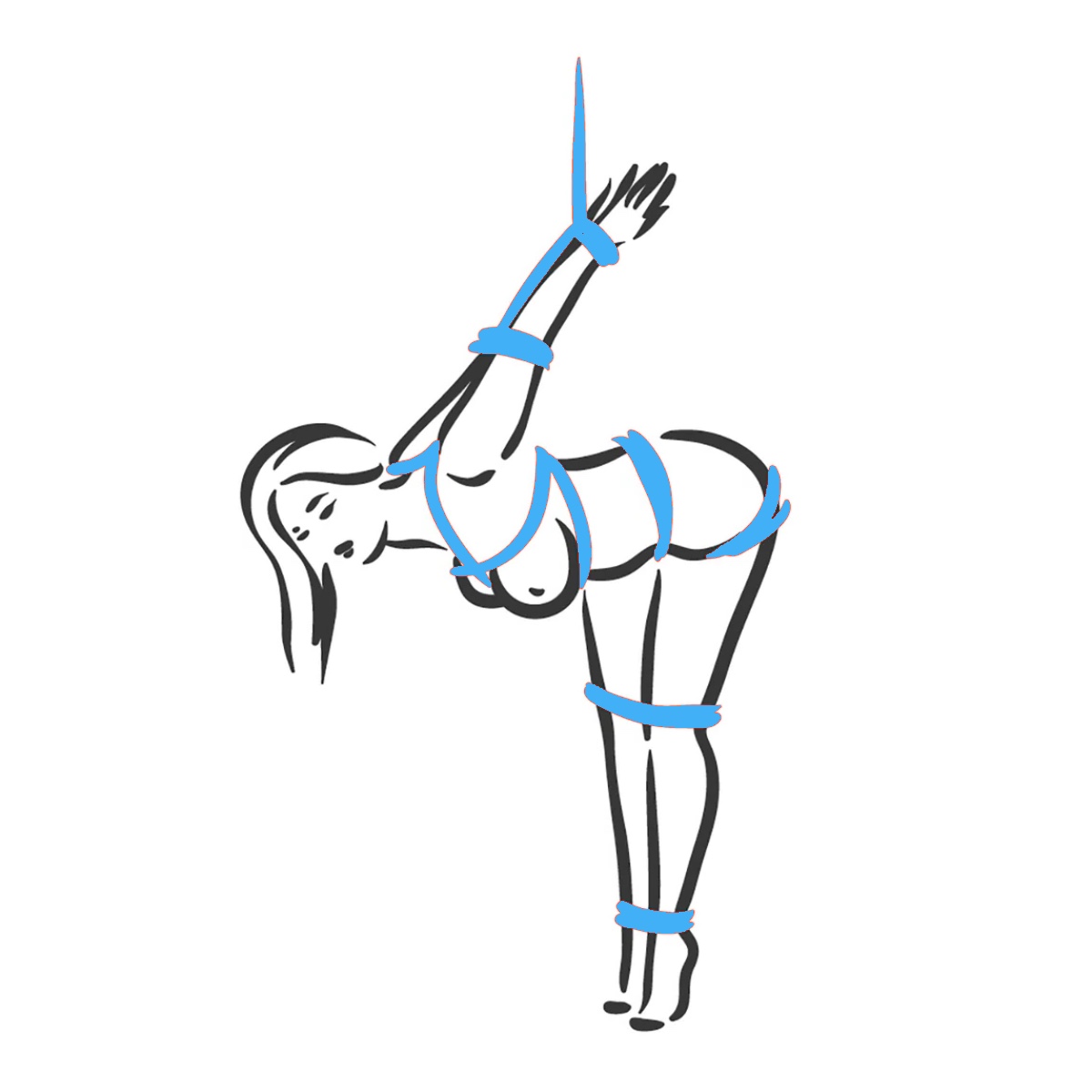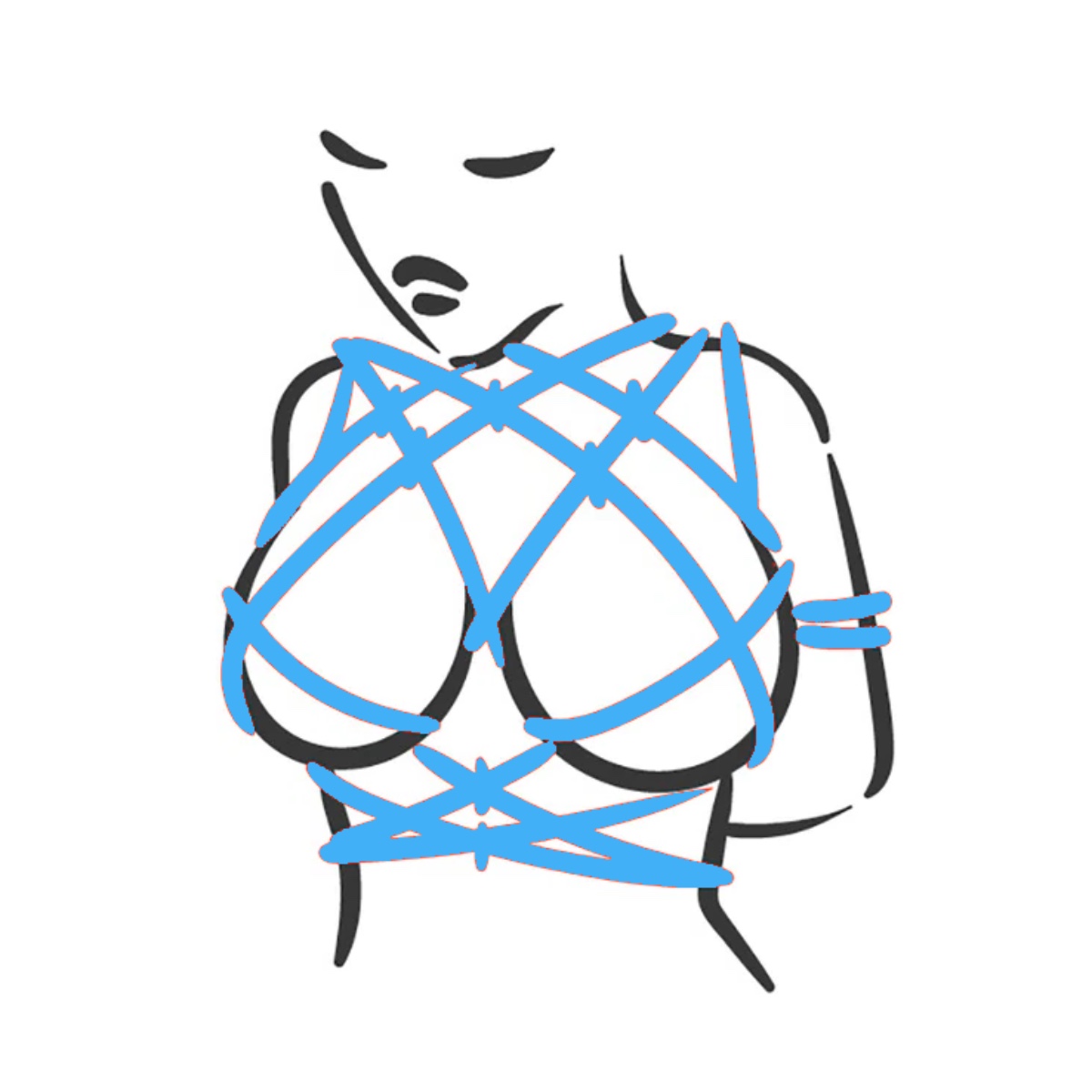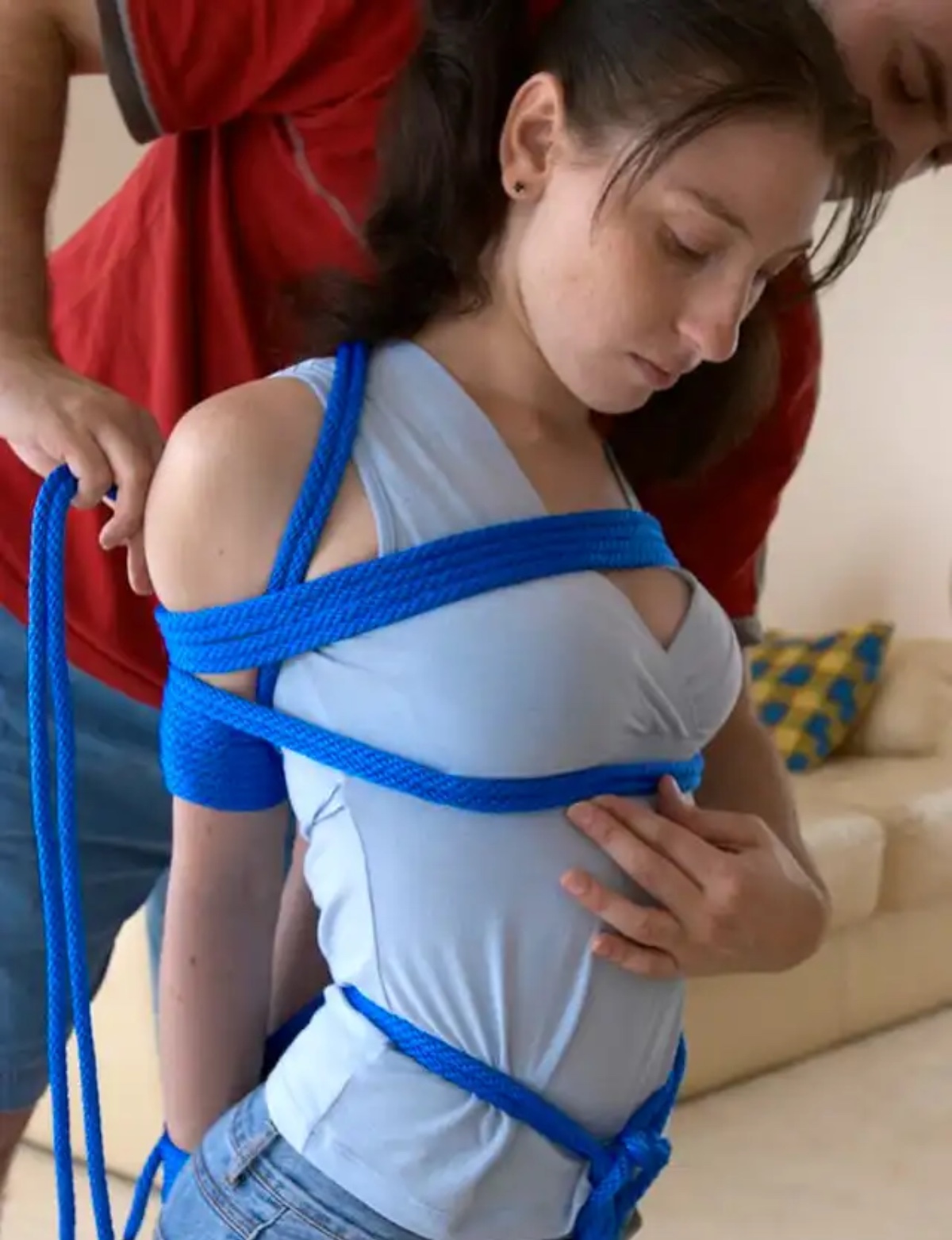Breast bondage is a popular practice within the BDSM community, involving the use of ropes, straps, or other materials to bind the breasts. This form of bondage can be both visually appealing and physically stimulating, offering a unique way to explore trust and intimacy. Understanding and practicing safe techniques is crucial to prevent injury and ensure a positive experience for both partners. This article aims to provide detailed methods and best practices for breast bondage, ensuring that those interested in this activity can do so safely and responsibly.
Take a look at our other BDSM articles and check out this superb range of BDSM gear by clicking here.
Best Practices in Breast Bondage Techniques

Understanding Breast Bondage
Definition and Basics of Breast Bondage
For those seeking a definition of breast bondage it simply involves binding the breasts with ropes, straps, or other materials to create pressure and enhance sensitivity. This practice can be decorative, adding to the aesthetic appeal, as well as functional, increasing physical sensation and erotic stimulation. The primary goal is to achieve a balance between restraint and comfort, allowing for a pleasurable experience without causing harm.
Historical Context and Evolution of the Practice
The roots of breast bondage can be traced back to traditional Japanese Shibari, which emphasizes intricate rope patterns and knots. Shibari, originally developed for practical purposes, evolved into an art form that highlights the beauty of the human body and the rope. Over time, these techniques have been adapted and incorporated into modern BDSM practices, becoming popular for their combination of visual and physical stimulation.
Common Reasons People Engage in Breast Bondage
People engage in breast bondage for various reasons, including the desire for increased physical sensation, aesthetic enjoyment, and the enhancement of intimacy and trust between partners. For some, the practice serves as a way to explore power dynamics and submission. Others appreciate the visual and tactile aspects of the bondage, finding pleasure in the intricate patterns and the sensation of the bindings. Regardless of the reason, it is essential to prioritize safety and communication to ensure a positive and consensual experience.
Check out this range of rope by clicking here.
Safety Considerations
Importance of Safety in Breast Bondage
Safety is paramount in breast bondage to prevent physical harm and ensure a positive experience. Proper safety measures protect both partners and allow for a more enjoyable and trust-building activity. By prioritizing safety, you can explore breast bondage confidently and responsibly.
Risks Involved and How to Mitigate Them
Breast bondage can pose several risks if not performed correctly. These include circulation problems, nerve damage, and skin irritation. To mitigate these risks, use soft, body-safe materials and ensure that bindings are snug but not overly tight. Regularly check for signs of discomfort, such as numbness, color changes, or swelling. If any of these signs appear, loosen or remove the bindings immediately. Keeping sessions short and taking frequent breaks can also help maintain safety and comfort.
Establishing Safe Words and Signals
Safe words and signals are crucial in any bondage practice. A safe word like “red” can immediately stop all activities if one partner feels unsafe or uncomfortable. Non-verbal signals, such as dropping an object or tapping out, are useful if the person cannot speak. These measures ensure that both partners have a clear and reliable way to communicate their limits and needs during the session.
Ensuring Consent and Communication Between Partners
Open communication and mutual consent are fundamental to any bondage activity. Before starting, discuss boundaries, limits, and preferences with your partner to ensure both of you are comfortable with the planned activities. Continuous communication during the session allows for adjustments and ensures that both partners feel safe and respected. Consent should always be enthusiastic and can be withdrawn at any time. By maintaining open lines of communication, you can foster a trusting and positive environment for exploring breast bondage.
Check out this range of rope by clicking here.
Materials and Equipment
Overview of Materials Used in Breast Bondage
Various materials can be used in breast bondage, including ropes, tapes, and straps. Each material offers different benefits and drawbacks, influencing the overall experience.
Benefits and Drawbacks of Different Materials
- Ropes: Natural fibers like cotton, jute, and hemp are popular due to their softness and flexibility. They provide a comfortable feel and can be aesthetically pleasing. However, they may require more maintenance and can be rough if not properly conditioned. Synthetic ropes like nylon are durable and easy to clean but may cause friction burns if not handled carefully.
Check out this range of bondage rope by clicking here.
- Tapes: Bondage tape sticks to itself without adhesive, making it easy to use and remove without damaging the skin. Medical tape can also be gentle on the skin and is widely available. However, tapes are generally not reusable and can be less versatile than ropes.
Check out this range of bondage tape by clicking here.
- Straps: Leather straps and cuffs offer strength and durability, providing a secure bind. They can be more expensive and require regular care to maintain their quality. Velcro straps are adjustable and easy to use but may not offer the same aesthetic appeal as other materials.
Check out this range of bondage straps by clicking here.
Tips for Selecting the Right Equipment for Beginners and Advanced Practitioners
Beginners should start with softer, more forgiving materials like cotton ropes or bondage tape. These materials are easier to handle and less likely to cause injury. As you gain experience and confidence, you can explore more complex materials and techniques, such as jute ropes or leather straps. Always ensure that the equipment is clean and in good condition before use, and regularly inspect it for signs of wear and tear. By choosing the right materials and equipment, you can enhance both the safety and enjoyment of your breast bondage sessions.
Basic Breast Bondage Techniques
Simple Breast Harness
Step-by-Step Instructions:
- Preparation: Use a soft, flexible rope, ideally cotton or jute, approximately 15-20 feet long.
- First Wrap: Start by placing the middle of the rope against the back, just below the shoulder blades. Bring the ends of the rope forward, passing under the armpits and across the chest above the breasts.
- Second Wrap: Cross the ropes in front and bring them back around the torso, passing under the breasts this time. Continue alternating wraps above and below the breasts until you have several layers.
- Securing the Harness: Once you have enough wraps, tie the ends of the rope securely at the back. Use a square knot for added security, ensuring it’s not too tight.

Tips for Ensuring Comfort and Safety:
- Check the tightness regularly to prevent circulation issues.
- Make sure the rope isn’t digging into the skin.
- Communicate with your partner to ensure they are comfortable.
Box Tie
Step-by-Step Instructions:
- Preparation: Use a longer rope, around 25-30 feet, preferably soft cotton or jute.
- Initial Wrap: Have your partner place their arms behind their back. Start with the rope in the middle of their back. Wrap around the upper arms, just above the elbows, and bring the rope forward across the chest.
- Cross and Wrap: Cross the ropes in front of the chest and bring them back around, wrapping below the breasts. Continue this pattern, alternating above and below the breasts.
- Final Securing: Once you have enough wraps, bring the ropes back to the starting point and tie securely. Ensure the knot is easily accessible for quick release.

Adjustments for Different Skill Levels:
- Beginners should keep the wraps loose and practice with shorter sessions.
- Advanced practitioners can try more intricate patterns and tighter wraps but must always monitor for signs of discomfort.
Rope Bra
Step-by-Step Instructions:
- Preparation: Use a medium-length rope, about 20-25 feet, and ensure it’s soft and flexible.
- First Loop: Start by wrapping the rope around the torso, just below the breasts. Tie a knot at the back to secure the position.
- Creating the Bra: Bring the ropes up over the shoulders, crossing at the back, and then bring them down to create a pattern resembling a bra. Wrap around the breasts and bring the ropes back up over the shoulders.
- Final Adjustments: Tie off the ropes securely at the back or front, ensuring the knots are accessible and not too tight.

Tips for Secure and Aesthetically Pleasing Results:
- Ensure the ropes are evenly spaced and not twisted.
- Adjust the tightness to maintain comfort while achieving a secure bind.
- Use decorative knots or additional wraps for added visual appeal.
Advanced Techniques
Tight Binding Techniques
Detailed Instructions for More Complex Binds:
- Preparation: Use a long, flexible rope, around 30-35 feet, preferably jute or hemp for better grip and aesthetic appeal.
- Initial Wrap: Start by wrapping the rope around the torso below the breasts, similar to a simple breast harness. Tie a knot at the back to secure.
- Tightening Wraps: Bring the rope up and over the shoulders, crossing at the back, and then wrapping tightly around each breast individually. Ensure each loop is snug but not excessively tight.
- Creating Tension: Cross the ropes in front and bring them back around the torso, applying even pressure to each wrap. Finish by tying the rope securely at the back or front, ensuring the knot is accessible.
Safety Precautions and Adjustments:
- Regularly check for signs of impaired circulation, such as color changes or swelling.
- Ensure that the person bound can communicate any discomfort immediately.
- Adjust the tightness as needed to maintain comfort without compromising the binding’s security.
Incorporating Suspension
Introduction to Suspension in Breast Bondage:
Suspension bondage adds a new dimension to breast bondage, incorporating elements of weight and gravity. This advanced technique requires experience and specialized equipment, such as suspension rings or beams.
Step-by-Step Guide and Safety Tips:
- Preparation: Use strong, durable rope, ideally 40-50 feet, and ensure all suspension points and equipment are secure and capable of supporting weight.
- Base Harness: Begin with a simple breast harness or box tie, ensuring it is secure and comfortable.
- Connecting to Suspension Points: Attach additional ropes to the harness, connecting them to suspension points above. Ensure the ropes are evenly distributed to avoid excessive pressure on any single area.
- Lifting and Adjusting: Gradually lift the bound person, maintaining constant communication to adjust for comfort and safety. Make slow adjustments, checking for any signs of distress.
Safety Tips:
- Always have a spotter present to assist and monitor.
- Use quick-release knots and have safety scissors nearby.
- Limit suspension time to prevent circulation issues and fatigue.
Decorative and Aesthetic Techniques
Methods for Creating Visually Appealing Designs:
- Preparation: Select a long, soft rope, such as cotton or silk, for intricate designs. Plan the pattern before starting.
- Basic Pattern Creation: Begin with a simple breast harness or rope bra as a base. Add additional ropes to create symmetrical patterns, such as spirals or lattice designs, around the breasts and torso.
- Intricate Details: Weave smaller ropes into the base design, creating intricate knots and loops. Focus on symmetry and even spacing to enhance the visual appeal.
Balancing Aesthetics with Safety and Comfort:
- Ensure all bindings are snug but not overly tight, regularly checking for signs of discomfort or impaired circulation.
- Avoid placing too much pressure on sensitive areas, such as the nipples or ribs.
- Use soft materials to prevent skin irritation and enhance comfort.
By mastering these advanced techniques, practitioners can explore more complex and visually stunning breast bondage while maintaining a high level of safety and comfort. Always prioritize communication and consent to ensure a positive and enjoyable experience for both partners.
Aftercare
Importance of Aftercare in Bondage Practices
Aftercare is an essential part of any bondage session, including breast bondage. It involves taking the time to care for the physical and emotional well-being of the bound partner once the session is over. Proper aftercare helps both partners transition back to a normal state, reinforcing trust and intimacy.
Techniques for Soothing and Comforting the Bound Partner
Immediately after releasing the bindings, gently massage the bound areas to restore circulation and alleviate any discomfort. Use soothing lotions or warm compresses to relax the muscles and skin. Offer your partner water and a comfortable place to rest. Engage in calming conversation and offer reassurance to address any emotional needs.
Checking for Any Injuries or Discomfort Post-Session
Thoroughly inspect the bound areas for any signs of injury, such as bruises, abrasions, or lingering numbness. Discuss with your partner how they are feeling both physically and emotionally. Address any concerns promptly and provide appropriate care. It’s also important to monitor for any delayed reactions, as some issues may not be immediately apparent.
Common Mistakes and How to Avoid Them
Over-tightening the Bonds
One of the most common mistakes in breast bondage is making the bindings too tight. This can restrict blood flow and cause nerve damage. To avoid this, ensure that the ropes are snug but not excessively tight. Use the “two-finger rule” – you should be able to slide two fingers between the rope and the skin.
Using Inappropriate Materials
Inappropriate materials can lead to skin irritation or injury. Avoid using rough, abrasive ropes or any materials not designed for skin contact. Opt for soft, flexible ropes like cotton, jute, or bondage tape that is gentle on the skin. Always test new materials on a small patch of skin to ensure there are no adverse reactions.
Ignoring Safety Signals or Safe Words
Safe words and signals are crucial for maintaining safety during bondage. Ignoring these can result in physical harm and emotional distress. Establish clear safe words and signals before starting and respect them immediately if they are used. Continuous check-ins during the session can also help ensure safety.
Lack of Communication and Consent
Failing to communicate and ensure mutual consent can lead to misunderstandings and potential harm. Always discuss boundaries, limits, and preferences with your partner before starting. Regularly check in with each other during the session to ensure both partners are comfortable and consenting.
How to Identify and Correct These Mistakes
- Regularly check the tightness of the bindings and adjust as necessary.
- Use body-safe materials specifically designed for bondage.
- Establish and respect safe words and signals.
- Maintain open lines of communication before, during, and after the session.
Resources for Further Learning
Books, Websites, and Videos for Learning More About Breast Bondage
Several resources can deepen your understanding of breast bondage. Books like “The Two Knotty Boys’ Showing You the Ropes” and “Shibari You Can Use” provide comprehensive guides. Websites like FetLife and RopeTopia offer forums and instructional content, while YouTube channels such as Twisted Monk and BondageLife feature step-by-step tutorials.
Community Forums and Workshops
Engaging with the bondage community can provide valuable insights and support. Online forums like Reddit’s r/BDSMcommunity allow you to connect with others, share experiences, and ask questions. Local BDSM groups often host workshops and classes for hands-on learning.
Recommendations for Professional Guidance
For those seeking personalized instruction, professional dominants and bondage instructors offer private lessons. Look for reputable professionals with positive reviews and experience in teaching bondage practices.
Conclusion
This article has explored best practices in breast bondage, covering safety considerations, materials and equipment, basic and advanced techniques, aftercare, common mistakes, and resources for further learning.
Always prioritize safety, communication, and consent in all bondage activities. By following these guidelines, you can ensure a positive and enjoyable experience.
We encourage readers to delve deeper into breast bondage through the resources provided. Approach this practice with curiosity, respect, and a commitment to safety.
